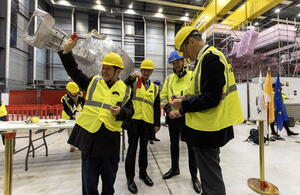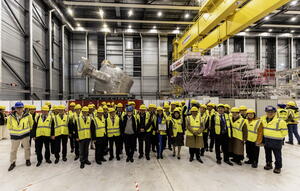Celebrating deliveries
Of the nine vacuum vessel sectors required to form the tokamak’s toroidal plasma chamber, five are already present on site. In the ITER Assembly Hall, two are being assembled into modules that will be installed later in the assembly pit. Another is undergoing repair in the former Cryostat Workshop, where two other recently arrived sectors have just been stored. The reception of the first vacuum vessel from Europe (out of five expected) on 25 October and that of the fourth and final sector from Korea on 8 November, was celebrated last week following the conclusion of the 35th ITER Council.
The celebration included several speeches by European and Korean stakeholders, an award ceremony, and the sharing of a tokamak-shaped cake in the former Cryostat Workshop under the towering presence of the massive components. Jan Panek, Europe’s Head of Delegation to the ITER Council, described the vacuum vessel sectors as “the most complex fusion structures ever built” and, like his Korean counterpart Deputy Science and ICT Minister Pan-sik Hwang, praised the “tireless dedication” of all those who had contributed to their successful manufacturing.
Marc Lachaise, director of the European Domestic Agency Fusion for Energy, noted that on the European side, “15 factories and several hundreds professionals” were involved in vacuum vessel fabrication. Kijung Jung, head of the Korean Domestic Agency, insisted on the quality of the collaboration between the two ITER Members. “As we have done up to this point,” he said, “we will move forward together, strengthened by the trust and mutual respect that we share.”
The audience also heard the testimony of representatives of industry. Marcello Parodi, the director of the AMW Consortium that was charged with vacuum vessel manufacturing in Europe, confided that he hadn’t expected “to feel such emotion” when he saw the European vacuum vessel sitting in storage on the ITER site. Kyung Ho Park, Vice-President of Hyundai Heavy Industries, noted that the journey that began in 2010 with the signature of the manufacturing contract had been “marked by continuous challenges” due to uniquely stringent requirements in terms of dimensional tolerances and quality standards.
The manufacturing and safe delivery of the ITER vacuum vessels was—and still is—the work of hundreds of specialists throughout the world. Addressing their representatives gathered onstage to receive a “Certificate of Appreciation,” ITER Director-General Pietro Barabaschi recalled, quite jokingly, how in its early phases the ITER project “was very fervent about complicating simple affairs, and even about further complicating affairs that were already complicated…”
But despite compounding organizational complexities on top of an already daunting industrial challenge … the job had been completed. And although the delivery of five vacuum vessel sectors and the finalization of four others is far from being the end of the road for plasma chamber assembly, the ITER Director-General marvelled at the fact that “we are where we are today.”




